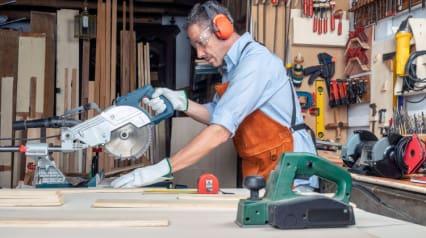What is Hearing Protection?
Hearing protection, simply put, is protecting your ears from dangerous noise levels, consequently preventing permanent hearing loss. Medical experts believe the best way to do this is by decreasing the volume or getting away from the source. If doing those are impossible, the next best thing is to wear protective gear that reduces the intensity of the sound entering your ears.
Importance
According to the Centers for Disease Control and Prevention (CDC), over 20 million people are exposed to dangerous noise levels at the workplace annually. The global numbers are even more staggering, with about 600 million at risk. Moreover, 16 percent of noise-induced hearing loss (NIHL) is directly linked to occupational noise.
The application of hearing safety measures is a must. Here’s why:
- Hearing loss is irreversible – Long-term exposure to occupational noise results in hearing loss. No medical treatment or surgical procedure can fix the damage caused. Worse, this could lead to mental health problems such as depression and cognitive decline.
- Excessive noise causes other distressing symptoms – Tinnitus (ringing in the ears), vertigo (sensation of spinning that leads to loss of balance), and insomnia (inability to sleep) has been reported as acute results of increased noise levels in the workplace.
- It reduces accidents – Studies show that hearing-impaired workers cannot distinguish the difference between machinery and alarm sounds, so they are more prone to accidents that cause fatal injuries.
- It increases workplace productivity – Poor job performance and absences are also associated with continuously high levels of noise. Aside from the aforementioned acute effects, any kind of noise is stressful. Properly managing this problem helps with employee productivity and, consequently, the business’s profitability.
- It protects your ability to communicate – Communication in any work setting is crucial in driving collaboration and boosting team productivity. More importantly, never let occupational noise negatively affect your relationship with family and friends.
Hazardous Noise Regulations
Decibel (dB) is the unit that measures sound. Humans can only take a certain decibel threshold. Anything above it may already cause injuries. The CDC created an interesting infographic that accurately describes the different sounds heard with their corresponding intensity. Here are some examples:
- Whispering – 30dB
- Ordinary spoken conversation – 60dB
- Lawnmowers and industrial fire alarms – 80 to 90dB
- Standing near an emergency siren or a hundred meters from an airplane – 130dB
- Pain-causing sounds – 140dB
The International Labor Organization (ILO) of the United Nations is responsible for setting labor standards among its member nations. They have defined the ‘safe level’ for occupational noise at 85 to 90dB if the noise is continuous and intermittent over an 8-hour work period. Other countries and their respective agencies have followed the same standard:
- Occupational Safety and Health Administration (OSHA), National Institute for Occupational Safety and Health (NIOSH), and the CDC in the United States
- Ministry of Labor, Canadian Center for Occupational Health and Safety (CCOHS) in Canada
- Safe Work Australia together with the different regulatory bodies per jurisdiction in Australia.
- Health and Safety Executive (HSE) and local authorities in the United Kingdom
- Department of Labor and Employment (DOLE) in the Philippines
- State Administration of Work Safety in China
- Ministry of Manpower and Transmigration in Indonesia
There are also specific government agencies and private organizations that ensure hearing safety standards are strictly followed in these highly-regulated sectors:
- Aviation
- Construction
- Mining
- Carpentry
- Manufacturing
- Railway
- Forestry, specifically in logging
Hearing Protection Standards
Hearing protection is more than just using earplugs and earmuffs. Other administrative controls are implemented to minimize or eradicate the threat posed by hazardous noise to workers.
Noise Evaluations
Since the ‘safe level’ for occupational noise has been set, companies should do routine tests to ensure that they are within the permissible range. Installing sound level meters and noise dosimeters is highly recommended. Audiometers and other laboratory-based tests must also be performed to check the viability of hearing personal protective equipment (PPE).
Noise Reduction
The first way to reduce noise is through engineering controls. This involves equipment (source of sound) modification or replacement or making specific changes to the path where sound travels to decrease its level.
- Designing a new workspace layout aimed at reducing sound emission
- Choosing a quiet or low-noise machinery
- Engineering controls on machinery (e.g., silencer, anti-abrasion rubber)
- Maintenance work on machinery (e.g., lubrication)
- Isolating noise source, if possible
- Creating barriers between source and worker
The second course of action is implementing administrative controls, which requires changing workflows and operational policies such as employee scheduling.
- Limiting the number of hours employees spend on a loud machine
- Limiting the number of employees in the space where the loud machine is located
- Providing quiet spots where workers can rest and relax
Hearing Protective Device
There are very few options for hearing PPE. However, all these are effective in reducing noise while allowing users to properly communicate with their co-workers. Listed below are the different kinds and the considerations for choosing them.
- Soft foam earplugs – This is the most common because it is a one-size-fits-all implement that is both effective and cheap. Reusing foam earplugs is not recommended, although some still do if they are clean and can expand to the original cylindrical shape.
- Custom or pre-molded earplugs – Made of silicone, soft plastic, or rubber, this ergonomic earplug is shaped like a honey dipper to match the contours of the ear canal. Custom-made ones are specifically personalized to the user and can be used repeatedly for years.
- Canal caps – These are thin, rigid headbands with either soft or pre-molded plugs at the end. The band holds the earplugs securely so they won’t fall off or get lost when not in use.
- Protective earmuffs – Similar to an audio headset, this consists of a band worn over the head with two foam cups that cover each ear. Some claim this is the most effective because it has more sound attenuation, is more secure, and can protect users from chemical splash. However, this is pricey, quite uncomfortable in hot and humid conditions, and is hard to wear with other PPEs like face masks and goggles.
While different companies have particular standards for wearing hearing protective gear, comfort and personal preference should still be considered because ear anatomy varies from one person to another. Companies should have all kinds available to ensure their workers wear them consistently.
Hearing Conservation
This administrative control aims to protect and preserve health and safety by equipping employees with the right knowledge and skills through continuous training. This also involves routine physical examinations to make sure that no worker develops hearing problems. If health problems are discovered, managers can immediately take the necessary action to mitigate them.
Improve Your Safety Performance: Start Using SafetyCulture Today
Eliminate manual tasks and streamline your operations.
Get started for FREE



